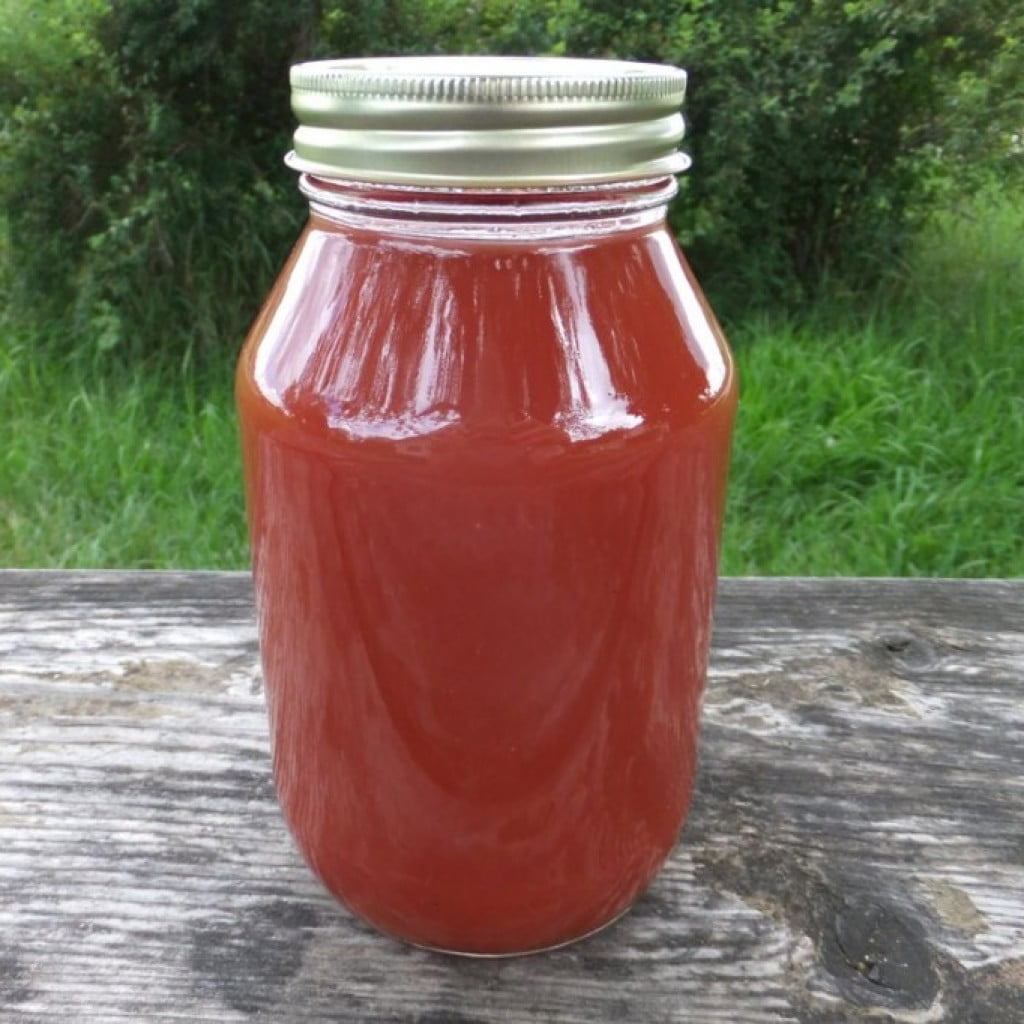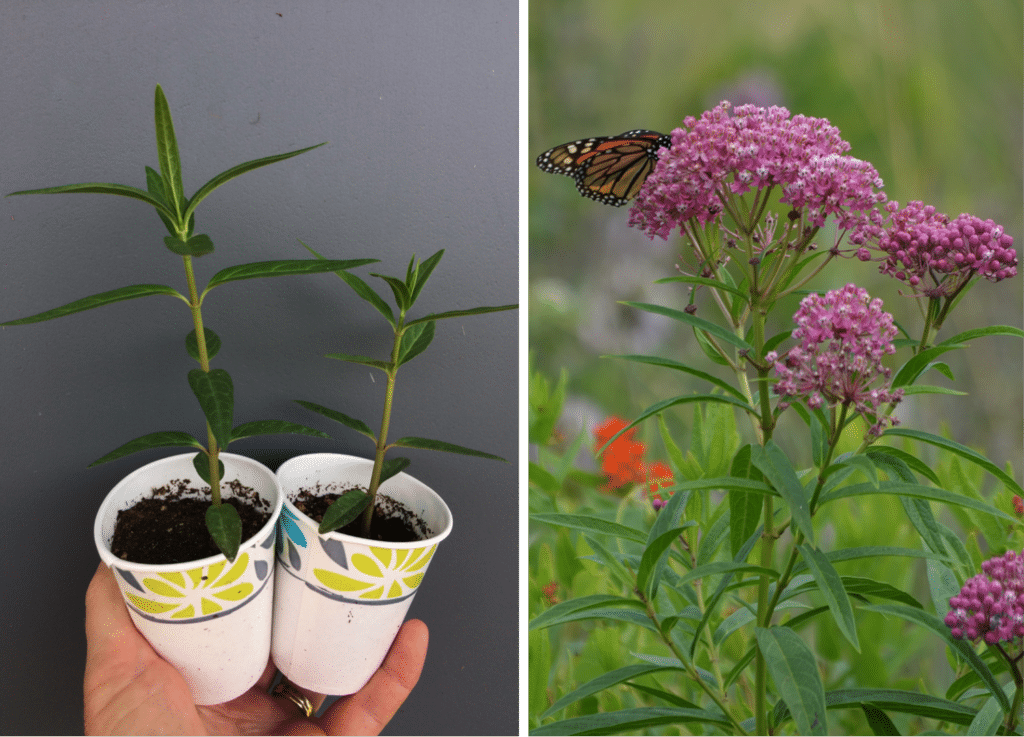Monthly Archives: July 2019
Week #10; Trust
- On: July 24, 2019
 0
0
Employee Raul Casique Montes came to us with 17 years experience on vegetable farms in Illinois. He quickly took over most of our cultivation work. This is a high-skill job. Over the past few years, we’ve invested in a suite of modern, European-made cultivating tools, which we then mount on 65-year-old tractors. We trust Raul to decide when and how to cultivate each crop. It takes finesse and attention to the weather, soil, and how the crops are growing. There are tools to choose, plus fine adjustments to get as close as possible to the crop without damage. On a farm of our size, Steve and I cannot make every decision. We need this kind of expertise and independent decision-making. It’s such a relief to have someone trusted in this role.
Let’s explain why cultivation is so important. The #1 pest on every organic farm is weeds. If diseases or insects run amok, we might lose part of our yield. If we lose control to weeds, we lose the entire field. That happened last year for celeriac and leeks. It was too wet to cultivate in June and July, and that was the end of those crops. Keeping weeds at a tolerable level is a constant job, first with cultivation by tractor, then hoeing, then finer hand work close to the plants. Hand-weeding is expensive! And arduous! And no one likes doing it! We have to be deliberate about hand labor we assign to our crew because of the expense. The more we can accomplish mechanically, the better. We prefer to save our crew time for harvest and other jobs where their expertise is essential.
Let’s take a look at a few crops we won’t touch with a hoe at all this year. Beth

This is a small planting of direct-seeded cucumbers. Instead of growing the plants in the greenhouse, then transplanting as seedlings, we sowed the cucumber seed directly in the ground. If we can control weeds, this is a good approach because it saves the effort of transplanting the seedlings. Unlike the earlier cucumber fields, these plants don’t need protection from cold spring weather.

These are our fancy German-made finger weeders in action. This tool showed us how close we can cultivate crops without damage.
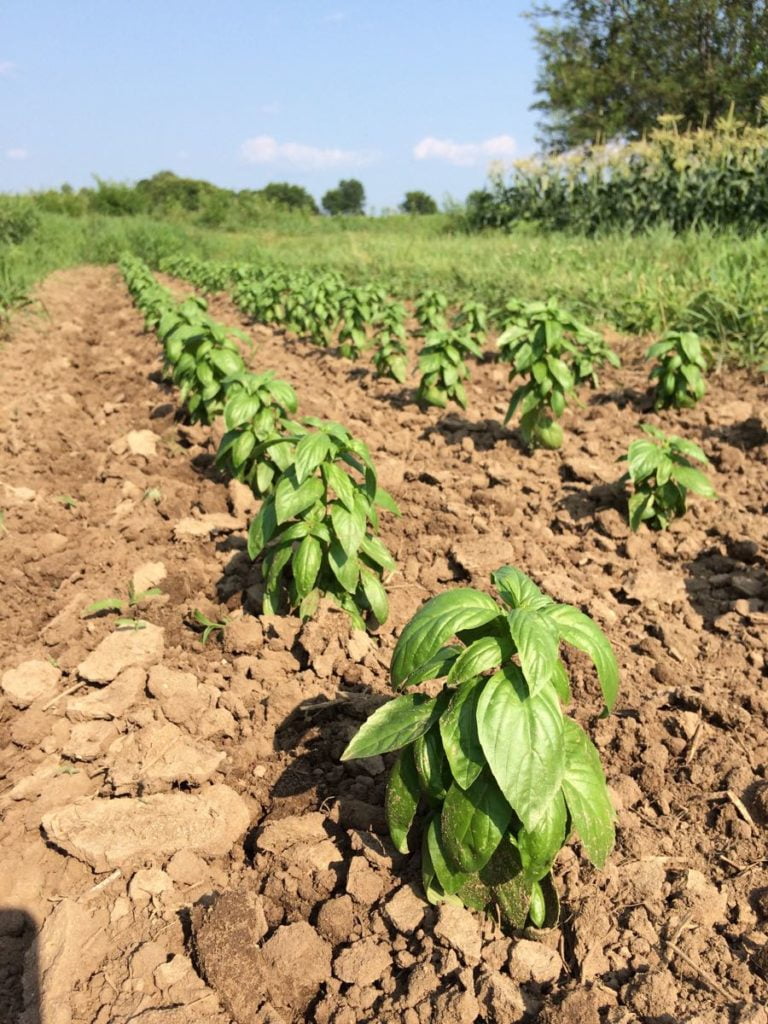

Look at how clean this basil field is after cultivation. We will begin harvest within two weeks, and will complete the crop without any weeding by hand. Basil is tricky. We’ve changed how we grow basil in response to a disease that showed up in the Midwest in 2010. We can no longer grow large bushy basil plants – they are too susceptible to disease. Our solution is to establish sequential plantings for harvest while the basil is young, before disease is a problem. It’s an excellent approach, as long as we don’t invest time weeding by hand, a perfect situation for close cultivation. FYI, we’re testing new disease-resistant varieties in this planting, to give us more options.
Veggie List and Veggie Notes
Week #10, July 25/26, 2019
– Weekly shares
– EOW/ green
Sweet corn, 8 or 9 ears
Caraflex cabbage, 1 head
Green beans, ~2/3 lb
Broccoli, several medium heads
Green leaf lettuce, 1 medium
Cucumbers, ~3
Zucchini &/or summer squash, 1 – 1.5 lb
Walla Walla onion
Purple bell or frying pepper, 1
Cherry tomatoes OR a small bag of plum or slicing tomatoes
Next week’s box will probably contain sweet corn, tomatoes, cucumbers, lettuce, carrots, green beans and more.
Sweet corn – Now it’s summer! Some ears have bugs at the tip. I suggest cutting off the tips before shucking the corn.
Storage. Sweet corn is best when fresh, so we encourage you to eat it asap. Store in the refrigerator, in the husks if you have the room.
Cooking. It is quicker to steam sweet corn than to boil it.
1.) Stand ears of corn upright in a tall pot. Put one inch of water in the pot.
2.) Bring the water to a boil. If the corn is cold when you begin cooking, steam for 5 – 6 minutes. If the corn starts at room temperature, steam for 4 – 5 minutes. The cooking time will vary somewhat depending on how many ears are in the pot. Pay attention to how the corn smells. The scent changes once the corn is ready. Another clue: water will bead on the corn until it is cooked. Don’t overcook it.
Caraflex cabbage – This ‘salad’ cabbage is great for slaws but also handles light cooking.
Green beans – We packed the beans in a paper bag but they will wilt if left in paper. Either transfer to a container, or cover the paper bag with a plastic bag, e.g. a bag you saved from a previous CSA delivery. Store in the warmer part of your fridge.
Broccoli – This is probably the last broccoli until fall. We’re pleased with how productive this field was. Much of this week’s broccoli has uneven heads, the result of last week’s hot weather. The unevenness does not affect flavor.
RECIPES
Visit our 2019 Recipe Log or our 2018 Recipe Log or join our Facebook discussion group.
LOCAL THYME/ Comforting Classics
Parmesan Roasted Broccoli with Pine Nuts
Southwestern Black Bean, Corn, Zucchini and Tomato Salad
Shrimp, Cabbage and Refried Bean Tostadas
Chickpea, Chorizo and Vegetable Soup
LOCAL THYME/ Outside the Box Recipes
Marinated Broccoli and Tomatoes on a Bed of Lettuce
Blistered Cherry Tomato and Corn Salad
Cabbage Slaw with Cashews and Raisins
Green Beans Sautéed with Garlic, Anchovies and Cherry Tomatoes
LOCAL THYME/ Quick & Easy Meal
Maque Choux
????????????
RECIPES FROM LAUREN
SUMMER FIESTA SALAD
If making this dressing just seems like to much keeping you from dinnertime, feel free to us something bottled. You are looking for something creamy, tomato-based if possible, and a little spicy. This one isn’t tomato-based but I do adore it.
Serves 4-6
Takes 30 minutes
8-12 pieces thick-cut bacon
1/2 head Caraflex cabbage, shredded
1 green pepper, seeded and cut into thin strips
1 tablespoon lime juice
1 tablespoon olive oil
Kosher salt
4 ears corn, cooked 5 minutes in boiling water and kernels removed
1/2 Walla Walla onion, thinly sliced
1 cucumber, halved, seeded and thinly sliced
2-4 avocados, cut into cubes
Smoky Tomato Dressing
6 dried morita chiles (I highly recommend you find them at an ethnic grocery if you have the time)
4 garlic cloves
2 crushed tomatoes, cored (about 1/4 cup if using canned stuff)
1/4 cup red wine vinegar
1/4 cup honey
1 teaspoon Kosher salt
1 cup olive oil
- Place bacon on a baking sheet. Put in the oven and turn temperature to 400 degrees (do NOT preheat ahead of time, just start the preheat process once the bacon is in the oven). Set time for 20 minutes and let cook until fully browned and crispy.
- In a food processor, prepare your dressing by combining all ingredients except olive oil and process until combined. It will be a little chunky but don’t worry about that. Scrape down the sides and get the processor running again. Drizzle in olive oil slowly until it becomes emulsified (aka begins to look a little creamy). Pour into a mason jar.*
- In a medium bowl, combine cabbage and peppers. Toss with olive oil, lime juice and a couple pinches of salt.
- To prepare your salad, combine a cup or so of chopped lettuce with a couple handfuls of slaw in a dinner bowl. Top with corn, onion, cucumber, avocado and bacon. Drizzle with dressing.
*If you don’t use this dressing right away, keeping it in a mason jar makes it easy to shake and re-emulsify whenever you are ready to serve.
.
????????????
.
SHREDDED ZUCCHINI PIZZA
Adapted from Food52
Serves 4-6
Takes 1 hour (plus time to make the dough if preparing from scratch)
1/2 batch pizza dough (my favorite recipe is from Pioneer Woman and I always make it 2-4 days in advance for the best texture)
1-1/2 pounds shredded zucchini and/or summer squash (about 5 cups)
1 teaspoon Kosher salt
6 ounces shredded mozzarella, fontina or gruyere cheese
1/4 Walla Walla onion, sliced
1 green pepper, finely diced
3 tablespoons plain breadcrumbs
- Place zucchini or summer squash in a large colander with salt. Toss it gently and then let it sit for 30 minutes.
- Preheat oven as hot as your oven with go (usually 500 or 525 degrees).
- Once time has passed, use hands to squeeze out a handful worth of zucchini at a time. Place in a large bowl and add cheese.
- Roll out pizza dough to fit a baking sheet. It might be thin and need to be seriously stretched. Don’t worry. The thinner the crust, the better the outcome. Spread zucchini mixture over crust going all the way to the edges (not leaving a crust like you would in a regular pizza). Sprinkle with onions and peppers followed by breadcrumbs.
- Bake for 20-25 minutes until golden brown throughout. Cut and enjoy!
.
Week #9; Cold Spring + Blazing Summer = Normal??
- On: July 17, 2019
 0
0

Alex helped me harvest sunflowers this week. Does he remind you of anyone? Van Gogh, of course, without the happy smile.
Cold Spring + Blazing Summer = Normal??
The current weather is overcompensating for our cold spring. Are any of you familiar with “degree days”? Basically, it’s a measure of heat accumulation. Farmers use degree days to gauge a season’s warmth and development. They are useful in many ways, e.g. for predicting when pests will emerge.
During the cold spring, we were lagging below normal, by about 25%. We have accumulated so much heat in the last few weeks that our degree days have almost caught up; we are currently just 6% below normal. We are likely to surpass “normal” with the current heat wave. I say “normal” because, with climate change, any standards of “normal” are shifting.
Our summer crops are primed to use the heat. They were well-established with strong roots before the weather turned hot. Tomatoes, sweet corn, melons – they all love hot weather.
We are doing our best to keep up with the explosive tomato vines. We trellis varieties that are expected to have a long harvest season. It keeps the tomatoes off the ground so they don’t rot, makes them easier to find, and keeps paths open so we can get into the fields. Smitty and crew are keeping up with trellising. It’s an on-going job.
Watch out for the heat on Friday. We’re hustling to get our farm work done so everyone can go home early on Friday. It’s going to be a scorcher. Beth

Smitty winds twine around the tomato plants in a figure eight pattern so they are supported on both sides.
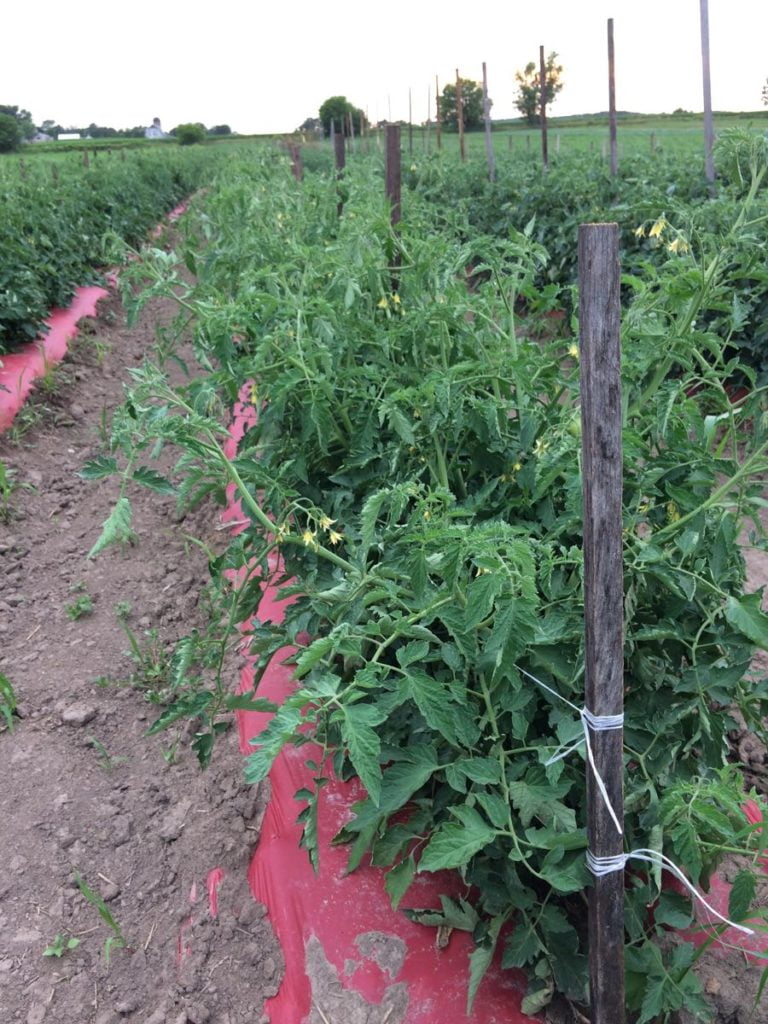
We need many posts keep the plants upright. These plants will be ready for a third string in a few days. See the taller posts in the row to the right? Those support cherry tomato plants which get quite tall.
Veggie List and Veggie Notes
Week #9, July 18/19, 2019
– Weekly shares
– EOW/ purple
– Sampler/ moon
Tipi tomato juice, 1 qt
Walla Walla onion
Green peppers, 2
Cucumbers, ~4
Zucchini &/or summer squash, 2.5+ lb
Collard greens, 1 bunch
Broccoli, several medium heads
Flowering dill, 1 small bunch
Sunflower
– Some sites get 1 green frying pepper.
– Some sites get 1 pt cherry tomatoes.
Next week’s box will probably contain Caraflex cabbage, cucumbers, Walla Walla onion, zucchini and more.
Tipi tomato juice – At peak season, we take our ripe tomatoes to a small batch processor in East Troy, to make into tomato juice for all of you. It’s a great way to capture ripe tomatoes when abundant. Drink the juice or try making an easy soup. Simmer your choice of vegetables from the box in the juice (diced zucchini, bell peppers, &/or broccoli). Add minced Walla Walla onion near the end of cooking. If you have some basil or parsley to add, that’s good but optional. Voila! Soup!
Storage: Store the juice out of sunlight at room temperature when unopened. Refrigerate after opening. The juice is already seasoned so do not add salt if you cook with it.
Ingredients: organic tomatoes from Tipi Produce, salt, organic garlic, organic onion, organic black pepper. Nutritional information is posted here.
Walla Walla onions – These fat onions are sweet, crisp and very mild. Wonderful raw or lightly cooked. Try cutting into wedges, threading on a skewer and grilling. Do not try to fry these onions – it doesn’t work because of their high water content. Storage: It’s OK to store at room temperature for up to one week. Otherwise, refrigerate.
Green peppers – Here are the first bell peppers. Refrigerate but in a warmer part of your fridge.
Flowering dill – We’ve timed the dill for delivery with lots of cucumbers, so you can make refrigerator pickles. Both leaves and flowers can be used as an herb. Storage: Refrigerate. Wash and freeze if you don’t plan to use within one week.
Sunflower – Trim your sunflower stem once you’re home and put in a jar or vase. The sunflower is for beauty and joy, not to eat! If you re-trim the stem and change the water a few times, the flower should last about one week.
RECIPES
Visit our 2019 Recipe Log or our 2018 Recipe Log or join our Facebook discussion group.
Grilled vegetables
This is a great weekend to throw vegetables on the grill and avoid heating up the house! Add your grilled veggies to pasta, rice or grain bowls, or make Lauren’s Noodle Bowl recipe below. Beth
Zucchini – Slice lengthwise, about 1/4 to 1/2 inch thick. Marinate in your favorite sauce for 15 minutes. Make sure the marinade contains some oil. Grill until soft and a bit charred, flipping once or twice. Return to the marinade to soak up flavor.
We use this mixture: 2 Tbsp soy sauce + 2 Tbsp rice vinegar + 1 Tbsp toasted sesame oil.
Walla Walla onion – Cut in wedges. Thread onto skewers. Rub or spray with oil. Grill, turning occasionally, until nicely charred and sweet.
Peppers – Even green peppers are delicious when roasted!
1. Instead of roasting intact peppers, I prefer to cut each pepper into 3 or 4 slabs (depending on the pepper’s shape), oil the pieces, and lay them flat on the grill. Start with the skin side up, then flip and grill with the skin side down until lightly charred. Do not blackened the entire skin. Place in a bowl, cover with a cloth for 5 minutes, then peel off the skins.
2. Alternatively, you can thread bite-size pepper pieces onto skewers and grill. You’ll have to pull off some charred edges but you get roasted pepper flavor, without the hassle of peeling the skins.
LOCAL THYME RECIPES
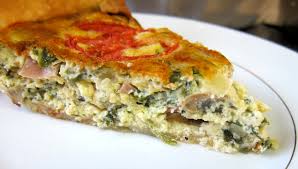
Puff Pastry Quiche with Broccoli
LOCAL THYME/ Comforting Classics
Spiced Chickpea and Chopped Vegetable Salad
New and Improved Zucchini Bread
Spiced Tomato Juice Stewed Greens
Puff Pastry Quiche with Broccoli
LOCAL THYME/ Outside the Box Recipes
German Braised Cucumbers
Lemon Blueberry Zucchini Cake with Lemon Glaze
Slow Cooker Pork Stuffed Collard Rolls
Broccoli, Cucumber and Pepper Salad with Sesame
LOCAL THYME/ Quick & Easy Meal
Szechuan Grilled Zucchini and Pepper Kebabs with Shrimp
????????????
RECIPES FROM LAUREN
CREAMY CUCUMBERS
Serves 2-4 as a side (though I am known to eat the whole bowl for dinner)
Takes 15 minutes (but gets better the longer you let it sit)
4 cucumbers, cut into 1/8-inch slices
1 Walla Walla onion, halved and sliced
1/3 cup Greek yogurt
1/3 cup mayonnaise
2 tablespoons sugar
2 tablespoon white vinegar
Salt and pepper to taste
Dill, optional
- In a large bowl, combine cucumbers and onions.
- In a small bowl, whisk together yogurt, mayo, sugar, vinegar, salt and pepper until smooth. Pour over cucumbers and onions and toss gently to combine. Garnish or season with dill (if you like).
- Serve immediately or chill for an hour to let the flavors really meld together.
.
????????????
.
MISO ROASTED VEGGIE NOODLE BOWL
Adapted from Sweet Lizzy
Serves 4-6
Takes 1 hour
1-2 pounds broccoli, cut into florets
1-2 pounds diced zucchini and/or summer squash
4 tablespoons olive oil, divided
1 tablespoon white miso paste
2 tablespoons maple syrup, divided
1 tablespoon soy sauce
1 tablespoon toasted sesame oil
4 cups roughly chopped mushrooms (I used a mixture of shittakes and cremini)
8-10 ounces rice noodles (I love the Lotus Foods Millet & Brown Rice Ramen)
1 bunch collards, stems removed and cut into very thin slices
1 tablespoon lemon juice
2-3 avocados, sliced
1/2 cup Almond Miso Dressing (see below)
2 tablespoons white or black sesame seeds, optional
Kimchi, optional
- Preheat oven to 400 degrees.
- Spread out zucchini and broccoli on a parchment paper-lined baking sheet. If you decide to use the full two pounds of each vegetable, you may want to use two parchment paper-lined baking sheets for more even browning.
- In a small bowl, whisk together 3 tablespoons olive oil, white miso paste and 1 tablespoon maple syrup until smooth. Brush broccoli and zucchini with this mixture then roast for 20 minutes. Remove from the oven, toss veggies and then roast 20 minutes longer.
- In a medium saucepan, mix together soy sauce, toasted sesame oil and remaining 1 tablespoon maple syrup. Add mushrooms and toss until they’re well-coated. Cook over medium low heat for 15-20 minutes. The mushrooms will first release a lot of liquid, then reduce down. Once fully cooked and soft, remove from the heat.
- Cook noodles according to package directions.
- Divide collards evenly into dinner bowls. Add a bit of lemon juice, olive oil and a pinch of salt to each bowl. Gently massage collards until they turn a brighter shade of green (about a minute). Top with noodles and miso roasted veg. Spoon mushroom mixture (sauce and mushrooms) over noodles. Add 1/2 avocado to each bowl. Drizzle 2-3 tablespoons of Almond Miso dressing and then sprinkle with sesame seeds. Add kimchi to your preference.
.
ALMOND MISO DRESSING
1/2 cup almonds
5 tablespoons olive oil
3 tablespoons water
2 tablespoons rice wine vinegar
1 tablespoon white miso
1 tablespoon maple syrup
In a food processor, process almonds until finely chopped (so it looks roughly like minced garlic). Add remaining ingredients and process until smooth. You may have to scrape down edges a couple times.
.
Week #8, Steve’s odd ambition
- On: July 10, 2019
 2
2
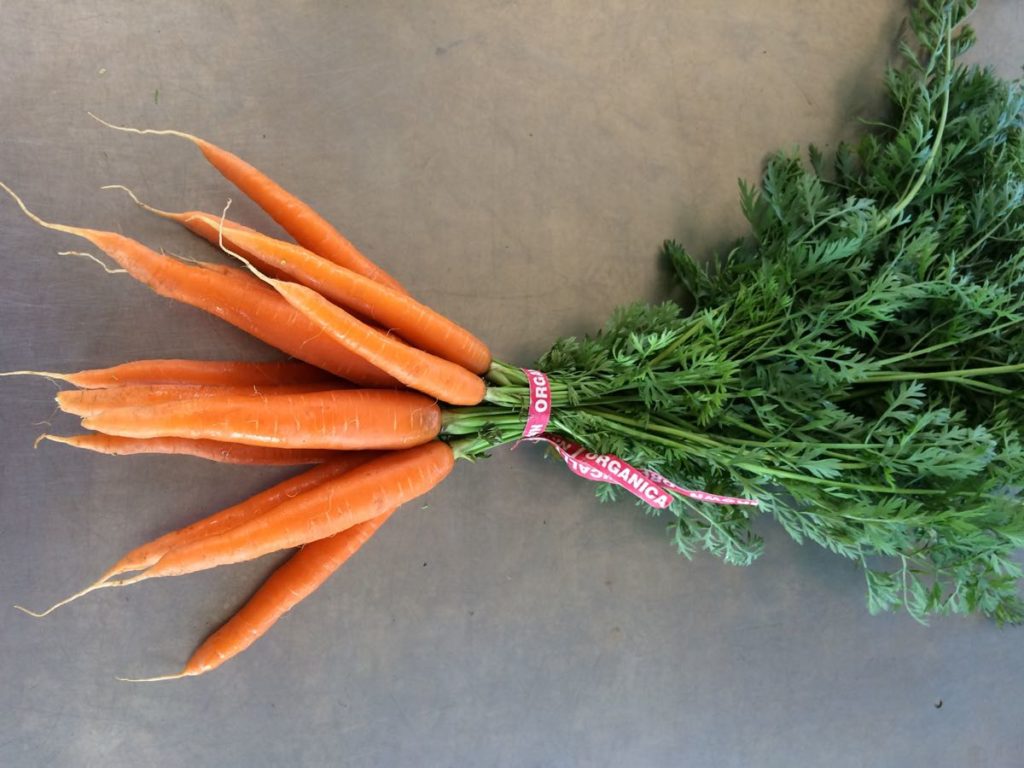
The first bunched carrots from Tipi Produce in over 25 years.
Steve surprised us by announcing a plan to bunch carrots for the CSA. “Bunched carrots” means carrots with the tops still attached. We grow many carrots but harvest just the roots. There are good reasons for that. We have the right mechanical harvester. It’s an efficient system that lets us grow lots of carrots without too much hand labor. Carrots are heavy.
Our 20-year employees were befuddled – they have never bunched carrots. Steve presented his arguments:
“We have a beautiful stand of straight, healthy carrots.”
“The sandy field they’re growing in is dry enough that the soil won’t stick to the roots.”
“These early carrots are precious and some would be lost during machine harvest.”
We pointed out the downside; it takes a lot of hand labor to do the bunching.
He maintained his arguments all week, but gradually the real reasons began to pop out. “It’s time to run our new bed lifter through its paces.” That’s a new piece of equipment we imported from the Netherlands. He’s itching to try it out. Then a few days later, “Can’t we just try something new??” There’s the real reason. Steve has grown carrots for so many years, and just wanted to try something new. We all gave in. Beth

All hands on deck to bunch carrots. From left, David, Simone, Billy, Alex, Ben, Michio, Kerry and Maggie. Steve (yellow shirt, background) is headed to the tractor to dig more of the row.

This is our new bed lifter, a type of under cutter. We bought it to ease our sweet potato harvests. We’ve been using an older re-purposed implement. This should be a big improvement. We imported it from the Netherlands.
Veggie List and Veggie Notes
Week #8, July 11/12, 2019
– Weekly shares
– EOW/ green
Carrots, 1 bunch
Swiss chard, 1 bunch
Cucumbers, 3
Zucchini &/or summer squash, 2.5+ lb
Broccoli, 1 or 2 small heads
Snap peas, ~2/3 lb
Lettuce, green leaf OR red bibb
Garlic scapes, 1 small handful
Parsley, 1 bunch
Next week’s box will probably contain cucumbers, kale/collards, beets, broccoli, Walla Walla onion and more.
Bunched carrots – Here’s the kicker. 1. Pause and admire your pretty bunch of carrots. 2. Rip off the leaves. If you leave the tops on, they pull moisture from the carrots. If you’ve read this far, now you know my primary argument against bunched carrots. Eat the carrots and feed the tops to your rabbit or your compost pile.
Swiss chard (pretty bundle of green leaves) – Our crew did a nice job mixing colors for pretty bunches. Swiss chard is a close relative of spinach, but requires a bit more cooking. Use as a substitute in any recipe that calls for spinach, just cook the chard a little longer. Both stems and leaves are delicious. The stems requite longer cooking, so cut them free from the leaves when preparing. That allows you to cook the stems longer.
Cucumbers – I bet you all know what to do with cucumbers. First of the season, these came from a field that was a terror to transplant. Conditions were very rough and we doubted the plants’ survival. We are amazed and relieved at how well the plants have done. Storage: Cucumbers need refrigeration but do best at about 48 F. Store in a warmer part of your fridge – that’s the best compromise.
Parsley – We have harvested flat-leaved Italian parsley for you this week. It looks a bit different than curly parsley but they are used interchangeably.
RECIPES
Visit our 2019 Recipe Log or our 2018 Recipe Log or join our Facebook discussion group.
LOCAL THYME/ Comforting Classics
Bibimbap with Chard, Summer Squash, Snap Peas, Cucumber and Ground Pork
Chard Soup with Sausage, Scapes, Brown Rice and Chickpeas
Cannellini and Provolone Pasta Salad with Creamy Italian Dressing
Norway’s Cucumber Parsley Salad
LOCAL THYME/ Outside the Box Recipes
Herbed Ricotta Pesto with Linguine and Summer Squash
One Pot Chicken, Chard and Rice Dinner
Carrot and Cucumber Salad with Japanese Carrot Ginger Dressing
Cucumber Parsley Buttermilk Dressing
LOCAL THYME/ Quick & Easy Meal
Shanghai Style Beef and Broccoli Stir Fry
????????????
RECIPES FROM LAUREN
WILTED GREENS WITH POLENTA
I made and loved this with chard (especially because of the beauty of the chard stems), but you can absolutely make this dish with any leafy green (kale, collards, spinach). We consider it more of a side and usually serve it with grilled sausages for a simple summer meal.
Serves 4-6
Takes 30 minutes
4 cups water
1 teaspoon Kosher salt, plus more to taste
1 cup polenta
2 tablespoons olive oil
3 garlic scapes, sliced
1 bell pepper, diced
Freshly ground black pepper
1 bunch chard, stems sliced and greens roughly chopped, divided
1/4 cup water
1/4 teaspoon red pepper flakes
2 tablespoons butter
- In a medium saucepan, bring water and salt to a boil over high heat. Once boiling, whisk in grits. Reduce heat to medium and continue whisking for a minute or two so there are no lumps. Reduce heat to medium low and cook for 20 minutes, stirring occasionally with a metal spoon (or your whisk) to prevent clumping/sticking.
- Meanwhile, prepare your wilted greens. Heat olive oil in a large heavy skillet over medium heat. Add garlic, pepper and chard stems along with a sprinkle of salt and pepper. Saute for 5 minutes until soft.
- Increase heat to medium high. Add chard greens along with another generous sprinkle of salt and pepper. Stir a couple times then add water. Let wilt down for 5-10 minutes until greens are cooked and tender. Add red pepper flakes, taste and adjust flavors to your liking.
- By now your polenta should be thick and nearly finished. Turn off heat and stir in butter. Taste and adjust these seasonings as well. Serve polenta warm with a pile of greens on top.
.
????????????
SUMMER SALAD WITH BROCCOLI FALAFEL
Takes 1 hour
Serves 2-4
1 head broccoli, cut into florets
2 garlic scapes
1/4 cup diced parsley
15.5-ounce can chickpeas, drained and rinsed
1-1/2 teaspoons salt, divided
1 teaspoon paprika
1 teaspoon cumin
1 teaspoon red pepper flakes
3 tablespoons lemon juice, divided
6 tablespoons chickpea flour
1/2 cup rice wine vinegar
3/4 cup water, divided
2 tablespoons sugar
1 cucumber, seeded and sliced
2-3 carrots, peeled and cut into 2-inch long pieces
1/2 cup Greek yogurt
2 tablespoons tahini
2 tablespoons olive oil
1/2 teaspoon dried dill
1 head lettuce
Kalamata olives
Feta cheese, optional
- Put broccoli into food processor and process until it resembles a rice. Place in a cast-iron or heavy skillet and cook for 2-3 minutes over medium heat to release the liquid.
- Meanwhile process garlic scapes, parsley, chickpeas, 1 teaspoon Kosher salt, paprika, cumin and red pepper flakes. Process until very finely chopped. Add broccoli and process until just combined. Add 2 tablespoons lemon juice and chickpea flour and process until smooth and begins to come together. Remove blade from processor and roll the mixture into balls. Place on a parchment-lined baking sheet in the freezer while you prepare the rest of your salad.
- Combine rice wine vinegar with 1/2 cup water, sugar and 1/2 teaspoon salt. Whisk until sugar has dissolved. Add cucumbers and carrots. Let sit.
- In a small bowl, combine Greek yogurt, 1/4 cup water, tahini, olive oil, 1 tablespoon lemon juice and dill. Whisk until smooth then taste and adjust seasonings.
- Heat large pot filled with two inches of vegetable oil over medium high heat. Fry broccoli falafel balls for 3-4 minutes until browned but not burned. Drain the grease on a paper towel.
- Divide lettuce into four bowls. Top with quick pickled carrots and cucumbers, broccoli falafel, olive oil and feta, if using. Drizzle with tahini dressing.
.
Week #7, Honorary farmhands
- On: July 02, 2019
 0
0

Strawberry u-pickers, toiling in the heat.
The stars aligned for our strawberry upick last weekend. We had a lot of ripe berries and just the right number of people to pick them. It balanced perfectly, with enough berries for everyone who visited. This is unprecedented. With a big crop like that, we could easily end the day with unpicked berries that would be over-ripe by this week’s delivery, and therefore wasted. Fortunately, it all worked out. Honestly, strawberries are our riskiest crop because they are so easily damaged by the weather. It’s been wet this year but the thick straw mulch saved the berries.
It was hot during the u-pick. If you visited on Saturday, then you have experienced a challenging harvest day in the fields and can now call yourself an honorary farmhand. I think everyone left the farm happy with their berries, and slightly dehydrated. Beth
More milkweed next year
Demand was high for the milkweed seedlings I offered for retrieval at the u-pick. We have given them all away. I am pleased to know that many of you care about supporting monarch butterflies. I will grow a bigger batch of seedlings next year, enough for everyone. Sorry to disappoint some of you. Beth
Veggie List and Veggie Notes
Week #7, July 3/5, 2019
– Weekly shares
– EOW/ purple
– Sampler/ sun
Folks, do not be surprised if quantities in your box are different from the list below. I had to guess. Our harvest schedule is weird this week because of the holiday.
Strawberries, 1 quart?
Caraflex cabbage, 1 head
Sugar snap peas, 1.2 lb
Romaine lettuce, 1
Zucchini &/or yellow squash, 2.5 – 3 lb
Kohlrabi, 1
Fennel with fronds, 1 large or 2 medium
Garlic scapes, a handful
Cilantro, 1 bunch
Basil, 1 or 2 husky sprigs
Some sites get 1 sunflower per box.
Next week’s box will probably contain carrots, sugar snap peas, Swiss chard, zucchini & summer squash, lettuce, garlic scapes, an herb and more.
Strawberries – These are ripe. Eat soon.
‘Caraflex’ cabbage – This is a nice salad-type that we grow in summer. Don’t you love the pointy shape? It has thinner, more tender leaves than the usual green cabbage. Great in salads and slaws but can also be cooked. Here’s the description from the seed catalogue: “Inner leaves are tender, crunchy, and have an excellent, sweet and mild cabbage flavor. Perfect for summer salads, slaws, or cooked dishes.” We’re sending it this week so you can make slaw for your holiday picnics.
Kohlrabi (pale green, round vegetable with thick skin) – Crunchy and sweet, kohlrabi is a great addition to salads.
Storage: Kohlrabi bulbs will store for a month in the refrigerator.
Uses: Kohlrabi are good peeled and eaten out of hand, or added to sandwiches, or added to salads. It makes a nice salad on it’s own. You can grate it, slice it, or cut it into matchsticks. It’s also good cooked. If you have it, the Asparagus to Zucchini cookbook has a long list of kohlrabi suggestions.
Fennel (large vegetable with a fat bulb and lacy fronds) – Fennel is a ‘swing vegetable’; it can be used raw or cooked. Clean well and slice as thinly as possible for use in raw salads. It is good simply prepared with olive oil, lime or lemon juice, salt and shaved parmesan cheese. Cooking softens and sweetens fennel, and mellows its anise flavor. Both the bulb and leaves are edible. Here are ideas from Alice Water of Chez Panisse about how to use fennel: ‘It’s strong anise characteristic seems to suit fish particularly well. … We use fennel all the time. We add the feathery leaves to marinades for fish and to numerous salads, sauces and soups and we use them as a garnish, too. … The bulbs are sliced and served raw in salads in various combinations with other vegetables, parboiled for pastas; caramelized and served as a side dish; braised whole; or cooked in vegetable broths & fish stocks.”
Garlic scapes (curly green things) – Garlic scapes grow at the top of garlic plants. They look like flower buds but are actually clusters of tiny bulblets. We snap off the young scapes to direct the plants’ energy into forming garlic bulbs underground. Use scapes as a substitute for garlic cloves. They can be minced, mixed with olive oil, and added to stir fries or simple pasta dishes. The scapes can be sautéed, but will not brown like garlic cloves. Expect them to retain their crunch even when cooked, and to be milder than garlic cloves, closer in pungency to the green garlic we’ve sent.
Cilantro – Used in both Mexican and some Asian cuisines.
Storage: Refrigerate.
Basil – Yum, the first tender basil, perfect to combine with garlic scapes, zucchini, snap peas, etc.
Storage: Basil will blacken if stored in the refrigerator. It is best stored at room temperature with the cut ends in water, for example in a jar or vase. Treat it like a flower. Give the stem a fresh trim and change the water every day or two.
Sunflower (for some sites) – We continue experimenting with sunflowers. They are one of the few flowers that we can send in the CSA boxes. This cheerful variety ‘Vincent’s Choice’ does not produce pollen, making it a good choice to pack with vegetables. Trim the stem and place in water. Give the stem a fresh trim and change the water every day or two. It might last 5 – 7 days.
RECIPES
Visit our 2019 Recipe Log or our 2018 Recipe Log or join our Facebook discussion group.
LOCAL THYME/ Comforting Classics
Paprika and Oregano Roasted Kohlrabi
Lamb, Kohlrabi and Fennel Curry
Smoked Trout, Snap Pea and Basil Pasta Salad
Cabbage Kohl Slaw
LOCAL THYME/ Outside the Box Recipes
Kohlrabi Gorgonzola Gratinée
Fennel Summer Squash Slaw
Burrata Snap Pea Salad
Southwestern Slaw
LOCAL THYME/ Quick & Easy Meal
Creamy Zucchini and Spaghetti
.
????
.
RECIPES FROM LAUREN
PARCHMENT PACKET SALMON WITH SUGAR SNAP CILANTRO SLAW
Inspired by What’s Cooking Good Looking
Serves 4-6
Takes 45 minutes
1 pound salmon
1 lime, cut into thin slices
1 tablespoon olive oil
1 teaspoon Kosher salt, divided
1/2 teaspoon freshly ground black pepper, divided
3 cups snap peas, ends trimmed and sliced lengthwise (about 2/3 pound)
3 cups shredded cabbage
1/4 cup packed chopped cilantro
2-3 garlic scapes, minced
3 tablespoons mayonnaise
2 tablespoons Greek yogurt
2 tablespoons lemon juice
1/2 teaspoon sugar
- Preheat oven to 400 degrees.
- Take a piece of parchment and lay it on a baking sheet. Place lime slices in a row on the parchment paper and top limes with salmon. Drizzle salmon with olive oil, 1/2 teaspoon salt and 1/4 teaspoon pepper before laying a couple more lime slices on top.
- Fold up the parchment into packets by taking the two long sides and bringing them together in the middle, folding it so it seals. Take both ends and twist tightly. Fold parchment ends under salmon. Bake the salmon for 20 minutes until cooked through.
- Meanwhile, prepare your slaw by combine peas, cabbage, cilantro and scapes in a large bowl. Toss to combine then add mayo, yogurt, lemon juice, sugar, remaining 1/2 teaspoon Kosher salt, and remaining 1/4 teaspoon freshly ground black pepper. Stir until veggies are well-coated.
- When salmon is ready serve warm with slaw on top or on the side.
.
????
.
ZUCCHINI, KOHLRABI & FENNEL FRITTERS
Takes 30 minutes
Makes 8-10 fritters
Serves 2-4
1-1/2 pounds zucchini, shredded (about 4 cups)
1 large kohlrabi, shredded (about 3 cups)
1/2 fennel, cored and shaved
1/4 cup chopped basil and/or cilantro
2-3 garlic scapes, minced
1/2 cup flour
1 large egg
1/2 teaspoon Kosher salt
1/4 teaspoon freshly ground black pepper
Vegetable oil
- Place shredded zucchini, kohlrabi and fennel in a large cheese cloth and squeeze to remove most liquid.
- Add drained veggies to a large bowl with basil and/or cilantro, garlic scapes, flour, egg, salt and pepper. Stir to combine.
- In a large heavy skillet, warm 1-2 tablespoons vegetable oil over medium high heat. Reduce to medium low and add mixture in 1/3 cup portions to the skillet. Cook for 4-5 minutes until golden brown on one side and flip. Press mixture into a patty and cook additional 4-5 minutes until browned and cooked through.
- Serve warm with yogurt, ketchup or hot sauce.
.



